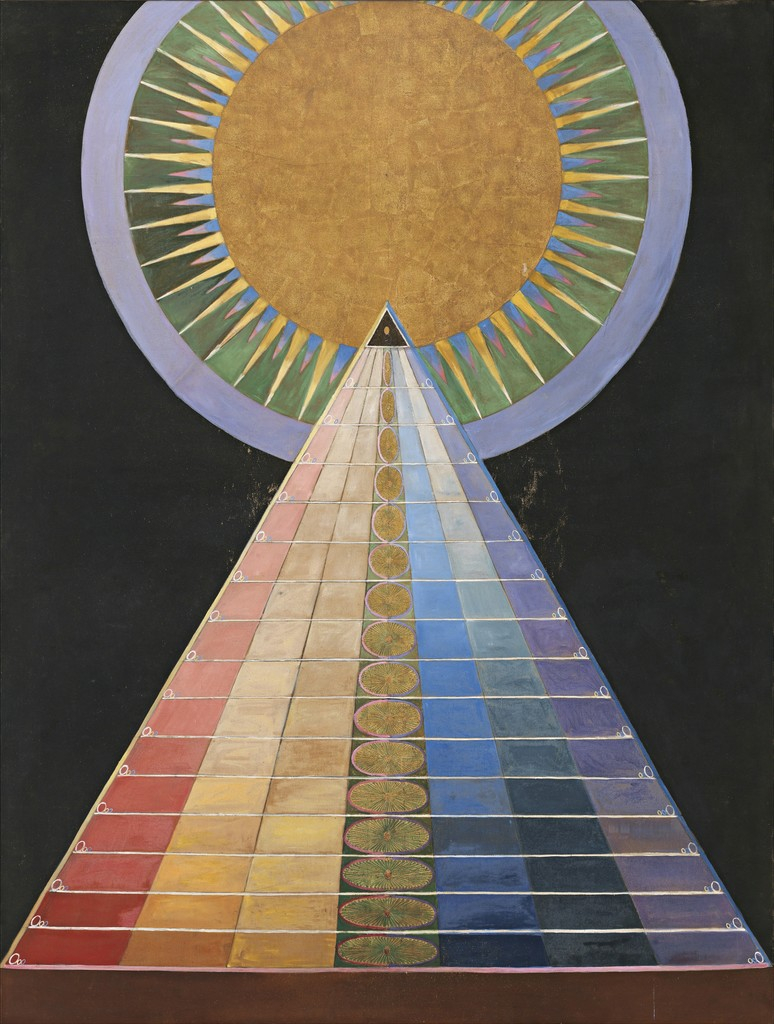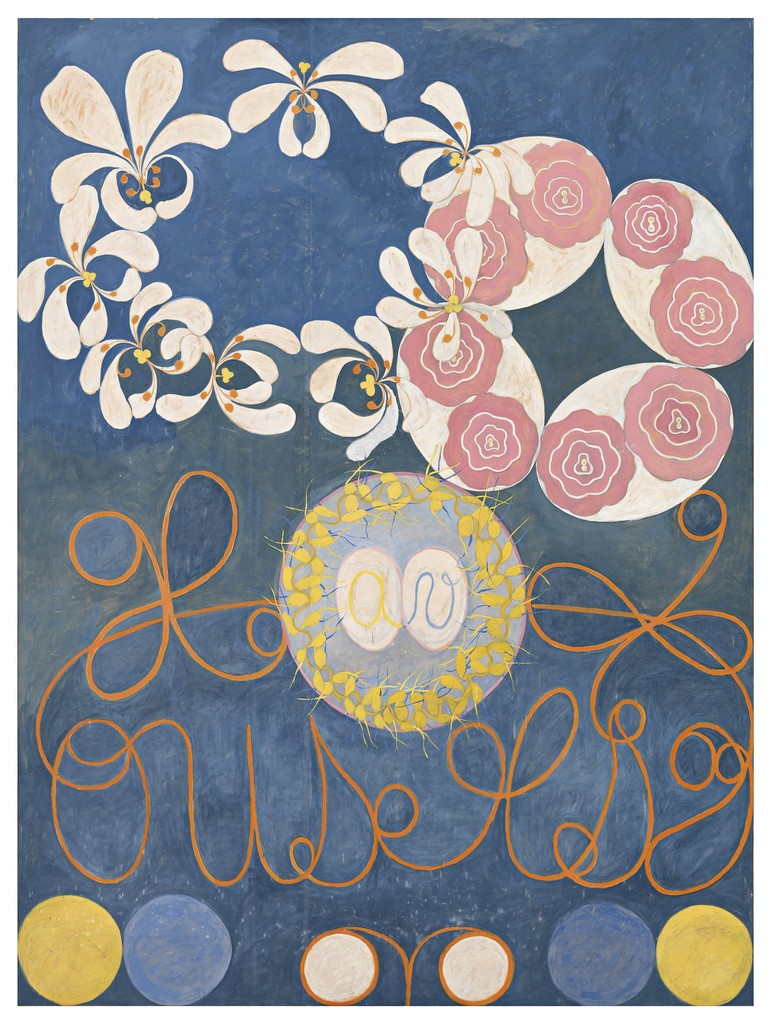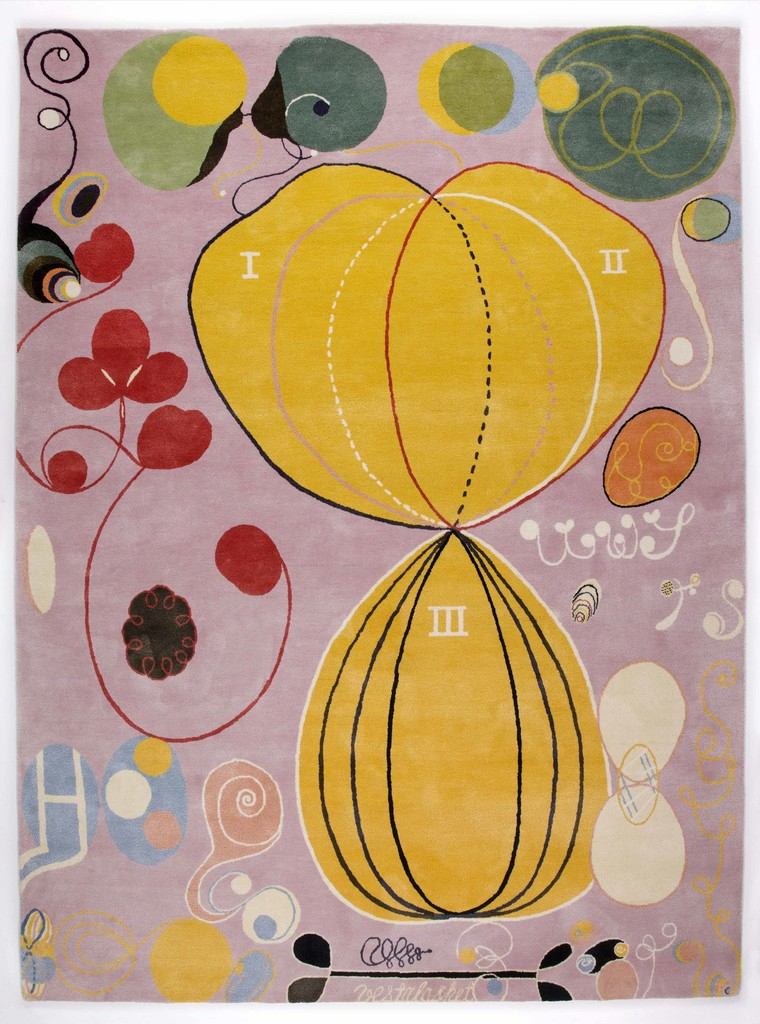
Hilma af Klint: Paintings for the Future
Soloman R. Guggenhiem Museum
Through April 23, 2019
"What is beautiful… which springs from the soul." Wassily Kankinsky
"Death is so abstract." Andy Warhol
"Believe" The private message Harry Houdini said he would send to his wife, during a séance, after his death, to determine the legitimacy of a medium.
"During the days when I was living alone in a foreign city… I quite often heard my name suddenly called by an unmistakable and beloved voice. I then noted down the exact moment of the hallucination and made anxious enquiries of those at home about what had happened at that time. Nothing had happened." Sigmund Freud
In 1969 the German painter Sigmar Polke painted a work entitled The Higher Powers Command: Paint the Upper Right Hand Corner Black! (1969). The picture he produced was just that, an empty canvas with a black triangle in the upper right corner, and to ensure the delivery of the punch line, he painted the command underneath: Höhere Wesen befahlen: rechte obere Ecke Schwarz malen! in an old typewriter font, as if the edicts from above were dictated and sent out like any other from the Head Office. What at first might seem to be merely taking the piss out of yet another "style," like Pop Art, AbEx, or Socialist Realism, Higher Powers symbolized a strain of spiritual abstraction that was distinctly German. Polke would himself dabble in the spiritual in art during the 1970s, via mushrooms, meditation, and the mindlessness of media. Whether or not Polke's audience saw the joke, in 1969, it was a knowing nod on Polke's part to the end of a certain type of avant-garde, one built by artists such as Hilma af Klint, where the viewer might believe they were having a genuine aesthetic, if not spiritual, relationship, through the artist, into something greater. Painting had once been a window into other worlds, showing the moral by way of the miraculous. The shorn breasts of St. Agatha, the disembodied eyes of St. Lucy gazing from a tray, or St. Clare, depicted with three balls, which were removed, post mortem from her body, and each of which magically weighing the same as the other two combined. These paintings were seen as vessels carrying messages from powers greater than ourselves; the history of Western Art has for the most part been a history of Western spiritual beliefs.

Hilma af Klint was born near Stockholm in 1862 and attended the Swedish Royal Academy of Fine Arts, graduating with honors in 1887. Predisposed to the mystical, she had begun attending séances at 17. This interest in the occult intensified after the death of her sister, ultimately finding kindred spirits in a group of women who called themselves The Five. Like many others at the turn of the century, The Five met to study Theosophy, Rosicrucianism, and Anthroposophy, and to hold séances. The turn of the century was filled with Steam Punk combinations of the religious, technological, spiritual, and scientific. William James, Arthur Conan Doyle, Harry Houdini, Wassily Kandinsky, and Helena Blavatsky were among the notable intellectuals on the same path.
At their regularly held séances, The Five would receive messages from mystic beings, the High Masters, which they would collect in notebooks and drawings. In these states of contact af Klint, speaking for Amaliel, Ananda, Clemens, Esther, Georg, and Gregor, the High Masters, announced plans to build a temple, which would be filled with paintings. In 1905 Georg and Ananda instructed af Klint to begin work on 193 large canvases. Using a psychograph, an instrument that received the dictations of Goerg and Ananda, af Klint embarked on a series of preliminary works, The WU/Rose Series, before beginning The Ten Largest, a series of large works that were tempera on paper, mounted on canvas, and all about 10 by 8 feet. Subdivided into the themes "Childhood," "Youth," "Adulthood," and "Old Age," The Ten Largest forms the core of the nearly 200 Paintings for the Temple. The earliest of these were painted under the specific instructions of the High Masters, though as the work progressed af Klint, as any prophet usually does, began interpreting more loosely the messages received. Af Klint's holistic approach to painting allowed her to use the picture plane as a receiving device. Drawing on her background at the Academy, where she studied botanical and anatomical drawing, af Klint created mixtures of floral, geometric, biomorphic, and calligraphic forms. Inventing languages for the High Masters, she created a rebus-like vocabulary where a tendril might become a spiral, or coiling calligraphic script; a snail might be inserted for scale reference; two orbs might represent two eggs or solar system diagrams; a set of Pantone-like swatches might be either the ascending colors of the chakra or an elevation of a pyramid. Platonic solids become organic forms.

A case has been made for af Klint's Ten series that these works might be the first purely abstract paintings, beating out Kandinksy by six or seven years. This Tesla vs Edison postulation precludes one fact: to af Klint, these were messages, about important things, not abstract forms; they represented content, just not content recognizable to us. Af Klint, a Late Victorian intellectual, had every reason to believe that the psychograph was communicating real messages, scientifically, from beings who inhabited a different time and space continuum.
Af Klint exhibited her works outside of her group only once, and, the construction of the temple aborted, she stipulated that the paintings not be shown until 20 years after her death. In a Houdini-like move, af Klint vanished for decades, her works magically reappearing in 1986 in an exhibition in Helsinki. There is a strange, Billy Pilgrim-like feeling to these paintings, which seem to have come unstuck in the fabric of art history.
Af Klint, like many artists of her period, was, to Clement Greenberg, "in search of the absolute." He continued, "The avant-garde arrived at 'abstract' or 'non-objective' art and tried in effect to imitate God by creating something valid solely on its own terms, in the way nature itself is valid; in the way a landscape, not its picture, is aesthetically valid. Something given, independent of meanings." In Group IV: The Ten Largest, No. 7, Adulthood (1907) we see af Klint wrestling with this notion, creating a new vocabulary, attempting to translate form into language. The biomorphic elements, a large yellow pod carefully annotated with Roman numerals, like a page out of a medical book, is combined with wallpaper-floral swirls. It is as if af Klint is trying to show us something magical and strange, and giving us a vernacular reference for context. In Group IV: The Ten Largest No. 3, Youth (1907) one is struck by the sense of modernity of the color, the candy-colored egg shapes, the zany spirals; the all-over composition feels like the opening credits to an Otto Preminger film, or the background for a Bugs Bunny dream sequence. What is of great interest is to imagine what might have been, what influence these works may have had, had af Klint chosen to share the High Masters' messages rather than tuck them away like a dowry. For all their modernity, they now carry with them the scent of lavender and moth balls.

If Post Modernism has taught us anything, it is that the history of art is a multiverse in which ideas and images appear and cycle at intervals, through different artists, at different periods. The fabric of that history is comprised of the work of many people -- the artist, the viewer, the collector, the critic, and finally, the artwork itself. The final tapestry, Art History, is greater than the individual threads and ultimately is a never-ending work in progress. The business of art is a collective work, which goes on from age to age, no single artist defining a period, no critic telling the whole story of their time, with any degree of certainty. No age has the final word. We can only interpret an art in the light of our own time and cultural understanding; other generations will add their perspectives, as well as remove the bits they no longer understand.
Art historians love apocryphal stories about painters: Pliny's Parrhasius and Zeuxis, Vasari's Leonardo and Raphael, Greenburg's Pollock, Schnabel's van Gogh. Af Klint was paid a visit by the Austrian educator and fellow spiritualist Rudolf Steiner in 1908. Steiner critiqued her work, advising her to move away from her spiritual inclinations and to work from her own ideas and intuition, a basic tenant of the Steiner school system. Af Klint abandoned her work on the Temple paintings, and stopped work altogether for the next four years, resuming painting, but never with the same interest. One is tempted, though, seeing Group IX/SUW The Swan No . 17 (1915), a severe yet very beautiful painting of concentric, colored circles, which seems steeped in Constructivism, Orphism, and Der Blaue Reiter, to wonder what might have been had af Klint not let things of the spirit come first.
